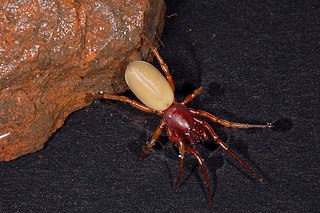
Wolf spiders are members of the family Lycosidae, from the Ancient Greek word "λύκος" meaning "wolf". They are robust and agile hunters with excellent eyesight. They live mostly in solitude and hunt alone, and do not spin webs. Some are opportunistic hunters pouncing upon prey as they find it or even chasing it over short distances. Some wait for passing prey in or near the mouth of a burrow.

Jumping spiders or the Salticidae are a family of spiders. As of 2019, it contained over 600 described genera and over 6000 described species, making it the largest family of spiders at 13% of all species. Jumping spiders have some of the best vision among arthropods and use it in courtship, hunting, and navigation. Although they normally move unobtrusively and fairly slowly, most species are capable of very agile jumps, notably when hunting, but sometimes in response to sudden threats or crossing long gaps. Both their book lungs and tracheal system are well-developed, and they use both systems. Jumping spiders are generally recognized by their eye pattern. All jumping spiders have four pairs of eyes, with the anterior median pair being particularly large.

Huntsman spiders, members of the family Sparassidae, are known by this name because of their speed and mode of hunting. They are also called giant crab spiders because of their size and appearance. Larger species sometimes are referred to as wood spiders, because of their preference for woody places. In southern Africa the genus Palystes are known as rain spiders or lizard-eating spiders. Commonly they are confused with baboon spiders from the Mygalomorphae infraorder, which are not closely related.

The Araneomorphae are an infraorder of spiders. They are distinguished by having chelicerae (fangs) that point diagonally forward and cross in a pinching action, in contrast to the Mygalomorphae, where they point straight down. Most of the spiders that people encounter in daily life belong to the Araneomorphae.

Dysderidae, also known as woodlouse hunters, sowbug-eating spiders, and cell spiders, is a family of araneomorph spiders first described by Carl Ludwig Koch in 1837. They are found primarily in Eurasia, extending into North Africa with very few species occurring in South America. Dysdera crocata is introduced into many regions of the world.

Tarantulas comprise a group of large and often ″hairy″ spiders of the family Theraphosidae. Currently, about 1,000 species have been identified. The term tarantula is usually used to describe members of the family Theraphosidae, although many other members of the same infraorder (Mygalomorphae) are commonly referred to as "tarantulas" or "false tarantulas". Some of the more common species have become popular in the exotic pet trade. Many New World species kept as pets have urticating hairs that can cause irritation to the skin, and in extreme cases, cause damage to the eyes.
Setia quisquiliarum is a species of minute sea snail, a marine gastropod mollusk or micromollusk in the family Rissoidae.

Spiders are air-breathing arthropods that have eight legs, chelicerae with fangs generally able to inject venom, and spinnerets that extrude silk. They are the largest order of arachnids and rank seventh in total species diversity among all orders of organisms. Spiders are found worldwide on every continent except for Antarctica, and have become established in nearly every habitat with the exceptions of air and sea colonization. As of July 2019, at least 48,200 spider species, and 120 families have been recorded by taxonomists. However, there has been dissension within the scientific community as to how all these families should be classified, as evidenced by the over 20 different classifications that have been proposed since 1900.

Trachelidae is a family of araneomorph spiders first described by Eugène Simon in 1897 as a subfamily called "Tracheleae". The Trachelidae family, also known as "ground sac spiders", is within the group of spiders known as the RTA clade, which includes mostly wandering spiders that do not use webs. Spiders in the Trachelidae family are characterized as being 3-10mm long and having a red cephalothorax and a yellow/tan abdomen. They are commonly found indoors. It was placed in the family Clubionidae, then later in Corinnidae when the Clubionidae were split up. The first study that suggested Trachelidae should be considered its own family was done by Deeleman-reinhold in 2001 as part of an analysis of RTA Clade spiders. An analysis by Martín J. Ramírez in 2014 suggested that it was not closely related to other members of the Corinnidae, and was better treated as a separate family. It was then placed in the CTC clade of spiders, or the Claw Tuft Clasper clade, which is a group of spiders that have two tarsal claws with tufts of hair.
Planus is a surname of French origin. People with that name include:
Utivarachna is a genus of Asian araneomorph spiders in the family Trachelidae first described by Kyukichi Kishida in 1940. It was largely ignored until Christa L. Deeleman-Reinhold revised the sac and ground spiders in 2001, transferring some species from Trachelas and adding several new ones. The genus was further expanded in 2014 and 2015.
Trachelas oreophilus is a species of spiders of the genus Trachelas. It is native to India and Sri Lanka.

Trachelas is a genus of araneomorph spiders originally placed with the Trachelidae, and later moved to the Corinnidae.

Trachelas pacificus is a species of true spider in the family Trachelidae. It is found in the United States and Mexico.

Trachelas tranquillus, the broad-faced sac spider, is a species of true spider in the family Trachelidae. It is found in the United States and Canada.
Trachelas volutus is a species of true spider in the family Trachelidae. It is found in the United States and Mexico.
Paratrachelas is a genus of araneomorph spiders in the family Trachelidae, first described by M. M. Kovblyuk & A. A. Nadolny in 2009.
Paenisporosarcina quisquiliarum is a bacterium from the genus of Paenisporosarcina.









